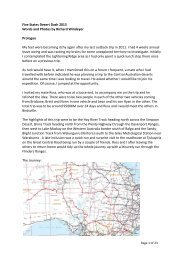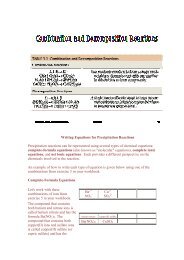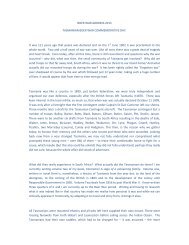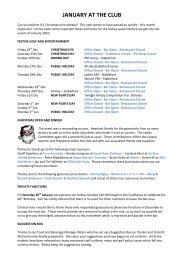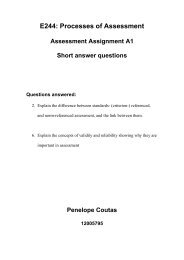Intro to Archery
Intro to Archery
Intro to Archery
Create successful ePaper yourself
Turn your PDF publications into a flip-book with our unique Google optimized e-Paper software.
INTRODUCTION TO ARCHERY<br />
TARGET ARCHERY<br />
This the most commonly practiced form of archery worldwide and is practiced within most <strong>Archery</strong> Australia clubs.<br />
Target <strong>to</strong>urnaments are conducted regularly and held both indoors and outdoors. Shooting distances vary from 18<br />
metres (indoor) <strong>to</strong> 90 metres (outdoor), with target sizes being 40 or 60 centimetres for indoors and either 80 or 122<br />
centimetres for outdoors.<br />
Targets have five colours with each colour being divided in<strong>to</strong> 2 <strong>to</strong> provide 10 scoring zones. The innermost ring is<br />
given a value of 10 points, down <strong>to</strong> the outermost ring with a value of 1 point.<br />
Target rounds involve shooting a set number of arrows over one or several distances. Indoor events involve shooting a<br />
<strong>to</strong>tal of either 30 or 60 arrows; with outdoor events shooting 72, 90, 120 or 144 arrows are shot.<br />
FIELD ARCHERY<br />
Field archery is a challenging outdoor discipline in which the archer takes on the terrain as well as the target. Field<br />
archery is a combination of archery, golf, and bush walking. A course is set up in a bush land setting taking advantage<br />
of hills, slopes, angles and light and shade.<br />
A field course is made up of either 24 or 28 targets depending on the round being shot. The archer is required <strong>to</strong> shoot<br />
either three or four arrows at each target. Distances range from 10 <strong>to</strong> 60 metres and target face sizes vary from 20 <strong>to</strong><br />
80 centimetres.<br />
CLOUT ARCHERY<br />
Clout archery is another popular discipline in Australia because due <strong>to</strong> its fun aspect. Clout archery is derived from<br />
medieval warfare where archers would lob arrows on<strong>to</strong> the advancing army. A target measuring 15 metres is diameter<br />
is marked on the ground, with a triangular marker placed at its centre. The archer's task is <strong>to</strong> lob arrows in<strong>to</strong> this<br />
ground-target from distances up <strong>to</strong> 180 metres depending upon gender and equipment.<br />
ARCHERY EQUIPMENT<br />
There are two main styles of bow used <strong>to</strong>day, recurve or compound bow. Also used in <strong>Archery</strong> Australia but not as<br />
popular are traditional longbows and crossbows where permitted by state law.<br />
Modern recurve bows are sophisticated devices. Typically made in three sections with a handle made from cast or<br />
machined aluminium, fitted with flexible limbs on each end made from laminates of carbon, fibreglass, and wood.<br />
Space age, non-stretch materials are used for bowstrings.<br />
Recurve equipment is the classic archery style and the only equipment use at the Olympic games. In the recurve style,<br />
few technical devices are permitted <strong>to</strong> enhance accuracy, assuring that the archer's strength and skill become the<br />
main fac<strong>to</strong>rs that determine performance.<br />
Compound bows are much more technically sophisticated than the recurve, the bow employing wheels or 'cams' at the<br />
tip of the limbs. Acting on a lever principle, these wheels allow an archer <strong>to</strong> draw and hold a bow with relative ease.<br />
The compound style also permits the use of aids <strong>to</strong> assist with accuracy such as hand-held 'triggers' for releasing the<br />
bowstring, and peep and magnifying sights.<br />
So what is the best equipment <strong>to</strong> use? It is the archer's choice of recurve or compound equipment; some prefer the<br />
graceful yet demanding aspect of recurve archery, and others prefer the intensity and deadly accuracy of compound<br />
equipment. Modem archery caters for both styles, as well as the other traditional styles such as crossbow and the<br />
traditional longbow.<br />
Arrows are made from either aluminium or carbon tube or a combination of aluminium tube wrapped in carbon fibre.<br />
These arrows provide a combination of both strength and lightness that allows them <strong>to</strong> reach speeds of up <strong>to</strong> 70<br />
metres per second.
Arrow Specifications<br />
For the archer's safety the length of the arrows used must always be slightly longer than that of the archers draw<br />
length otherwise the archer may end up pulling the arrow right back off the bow which is very dangerous. Equally<br />
important is the stiffness of the arrows used by the archer. Arrow shafts are available in a huge range of strengths<br />
designed <strong>to</strong> match the draw weight of different bows.<br />
This is very important since, if excessively weak arrows are shot from powerful bows they may snap when the string is<br />
released. At the same time, slight mismatches between arrow strengths and bow strengths will tend <strong>to</strong> cause poor<br />
arrow flight and thereby reduce accuracy. 'Matching' arrows <strong>to</strong> different bows is quite a science.<br />
Beginning archers should always consult a club coach or archery shop professional before purchasing arrows.<br />
COST OF ARCHERY EQUIPMENT<br />
Most archery equipment used in Australia is imported from wither the USA, Korea or Europe. The equipment is hightech,<br />
reliable, extremely safe, and accurate. The price of equipment is roughly equivalent <strong>to</strong> new golf gear.<br />
A considerable second hand market for archery equipment exists within most archery clubs, which trade at prices<br />
typically 50%-75% of the original cost. Some retail archery shops also sell second hand and reconditioned equipment,<br />
and occasionally offer good deals on superseded bow models.<br />
Before buying any archery equipment though, it is worthwhile consulting an accredited archery coach in order <strong>to</strong> work<br />
out all of your archery measurements and specifications. For more information contact your local archery club.<br />
A TYPICAL ARCHERY ROUND<br />
The program for a typical target archery round might run something like this - 30 arrows shot at a distance of 60<br />
metres, then 30 arrows shot at a distance of 50 metres, and then the final 30 arrows shot at a distance of 40 metres.<br />
This round is called a Canberra (or FITA 900) and is a very popular round shot regularly in most clubs.<br />
In the Canberra round arrows are shot in groups of 6 arrows, which is called, an “END”. The scoring and retrieval of<br />
arrows takes places after each end. A number of consecutive ends (5 in a Canberra round), each shot <strong>to</strong> a four minute<br />
time duration completes each distance. Such a round would take around three hours <strong>to</strong> complete. <strong>Archery</strong> Australia<br />
has devised a number of rounds that are shot in clubs. These rounds involve various combinations of arrows at various<br />
distances and provide both variety and a challenge.<br />
TOURNAMENTS<br />
Many of the rounds recognised by <strong>Archery</strong> Australia are shot at <strong>to</strong>urnaments There are 3 types of <strong>to</strong>urnaments Open,<br />
Divisional and Handicap. Tournaments also cater for the various types of equipment and sub equipment categories.<br />
Recurve or Compound Freestyle (using a sight and accessories)<br />
Barebow (not using a sight or accessories)<br />
Longbow (always shot Barebow)<br />
Crossbow (in some states you will need a permit)<br />
Open Tournaments. Open <strong>to</strong>urnaments cater for people of all standards although people shooting in a particular<br />
equipment and sub equipment category compete against all comers in the category irrespective of ability. These<br />
<strong>to</strong>urnaments do cater for gender (male and female) and age sections such as<br />
Open - All competi<strong>to</strong>rs (usually aged from 18 <strong>to</strong> 50 years) Veteran (Masters) – There are two age categories 50 <strong>to</strong> 60<br />
and 60 plus. Juniors - There are 4 age categories Under 12, Under 14, Under 16 and Under 18.<br />
Divisional Tournament. There are many Divisions <strong>to</strong>urnaments. These divisions relate <strong>to</strong> score levels within a given<br />
gender and age section. Such as Men Recurve Division 1, Division 2 and Division 3.Careful categorization by age,<br />
gender, and bow style aims for a situation in which archers possessing the same skill level and equipment are allowed<br />
<strong>to</strong> compete between themselves for the prizes. In a <strong>to</strong>urnament, the highest overall place getters in each Division win<br />
the Divisional trophies or medals.<br />
Handicap Tournament. In this type of <strong>to</strong>urnament, a handicap system similar <strong>to</strong> that used in golf is used. In a<br />
Handicap Tournament' each archer's pre-set handicap determines a certain number of 'bonus points' that are added <strong>to</strong><br />
the <strong>to</strong>tal score shot in the event. A Handicapper sets and adjusts these handicaps according <strong>to</strong> a formula provided In a<br />
handicap <strong>to</strong>urnament there are no Divisions. Typically, the <strong>to</strong>urnament winner will be the archer who shoots<br />
best score relative <strong>to</strong> his or her existing handicap.
Matchplay Tournament. Another exciting type <strong>to</strong>urnament is Matchplay. These are knockout competitions based on<br />
the system used by in the Olympic games. Archers first shoot a 'ranking' event <strong>to</strong> determine the draw for the<br />
competition, and then compete head-<strong>to</strong>-head in consecutive knockout matches <strong>to</strong> determine medal placing's. 'Ends'<br />
are usually reduced <strong>to</strong> 3 arrows <strong>to</strong> further intensify the competition<br />
GETTING STARTED<br />
The most important part of getting started in archery is <strong>to</strong> obtain correct advice and instruction.<br />
You should consult your local <strong>Archery</strong> Club or archery centre that can provide instruction given by an accredited<br />
archery coach. Most clubs provide equipment for instruction so you don't require your own equipment although you will<br />
be expected <strong>to</strong> obtain your own equipment if you wish <strong>to</strong> continue with the sport.<br />
How long is an Instruction Classes? This is up <strong>to</strong> the requirements of the club and coach, some provide "Come N Try"<br />
instruction, which is a quick session of about two hours while others provide formal instruction which could go for 3 <strong>to</strong> 4<br />
weeks of 2 <strong>to</strong> 3 hours a session.<br />
Eye Dominance<br />
The dominant eye is that which focuses on the target (while the non-dominant eye gives depth of field <strong>to</strong> one's vision).<br />
To shoot correctly the arrow should be located directly below the dominant eye.<br />
Eye dominance therefore determines which hand the archer should hold the bow with, and which hand the string<br />
should be drawn with. If the right eye is dominant then the bow must be held with the left hand and the string drawn<br />
with the right hand.<br />
Right eye dominance means that the archer should use what is called in archery right -handed equipment. If the left<br />
eye is dominant then the bow must be held with the right hand and the string drawn with the left hand. Left eye<br />
dominance means that the archer should use left-handed equipment.<br />
A simple method of determining eye dominance; Extend both arms directly <strong>to</strong> the front at<br />
Shoulder height, fingers <strong>to</strong>gether and palms facing away. Link the hands <strong>to</strong>gether so that<br />
V's are formed by the index finger and thumb <strong>to</strong> form a small opening.<br />
With both eyes open, look at a distant object through this opening. Now, looking at the object<br />
slowly draw your hands <strong>to</strong> your face. The opening created by your hands will end up over<br />
your dominate eye.<br />
Strength Threshold<br />
The physical part of archery - drawing the bowstring against the pressure of the bow's limbs - is essentially a weight<br />
lifting exercise. The amount of force required <strong>to</strong> draw the string fully is measured as a draw weight, in pounds of force.<br />
The stiffness of a bow's limbs and the length of draw determine this draw weight. In archery events the archer may be<br />
required <strong>to</strong> draw this weight up <strong>to</strong> 150 repetitions so using a sensible draw weight is important.<br />
Recommended Draw Weight (in pounds) at the archer's full draw length for your first bow:<br />
Recurve Compound Recurve Compound<br />
Junior (under 13) 10 – 15lb 20 –30lb Adult Women 15-25lb 25 – 35lb<br />
Junior (13- 18) 15 – 20lb 25 – 35lb Adult Man 20-30lb 30lb – 40lb<br />
Most modern compound bows have adjustable draw weights that allow the archer <strong>to</strong> set the bow within a 10-pound<br />
range. For example, an average sized 14 year old boy would get good service from a compound bow marked "20-30 lb<br />
Adjustable" by setting the bow on 20lb as a beginner, then increasing the draw weight a few extra pounds as his size,<br />
skill and experience grows.<br />
Recurve bows on the other hand are typically adjustable <strong>to</strong> within only two or three pounds of draw weight. Selection of<br />
a sensible draw weight at the beginning is therefore very important. As a rule of thumb, the higher-end weight ranges<br />
listed in the above chart should only be selected by recurve archers who are either naturally very fit or strong, or who<br />
are prepared <strong>to</strong> train regularly.<br />
'Natural draw length' is a term used <strong>to</strong> describe how far the archer draws back the bowstring <strong>to</strong> a fully extended<br />
shooting position. To determine an archer's natural draw length a light poundage bow fitted with a long arrow should<br />
be drawn <strong>to</strong> a comfortable 'full draw' position, with the arm holding the bow fully extended, the head held straight and
upright, and the string drawn straight back until it <strong>to</strong>uches the nose.<br />
The arrow is marked at the back (far side) of the bow. The archer's 'draw length' is measured (in inches) from this mark<br />
<strong>to</strong> the bot<strong>to</strong>m of the arrows nock groove (I.e. where the end of the arrow clips on<strong>to</strong> the bow string). When purchasing a<br />
bow, this draw length msut be specified.<br />
AWARDS<br />
<strong>Archery</strong> Australia provides a number of classification awards for an archer's performance at club state, state and<br />
national level. The award classifications in archery, in ascending order, are Third Class, Second Class, First Class,<br />
Master, and ultimately Grand Master. An archer improves their Classification by recording appropriate scores several<br />
times over the course of a calendar year<br />
There are a number of 'Performance' Awards’ available from the <strong>Archery</strong> Australia. These include awards for the<br />
achievement of 6-out-of-6 'GOLD' (i.e. scores of 9 or 10) in and 'end', or 6 out of 6 arrows in the 'TEN" (called a<br />
Perfect) at all distances from 18 <strong>to</strong> 90 meters.<br />
<strong>Archery</strong> Australia also awards medals for achieving scores at various events called Australian Stars and FITA Star,<br />
FITA Arrowhead are awarded for field and FITA Performance Awards for many other target events.<br />
SHOOTING CONTROL AN SAFETY<br />
<strong>Archery</strong> Australia and its Clubs take pride in their safe conduct of <strong>to</strong>urnaments and club activities. Rules and<br />
procedures have been developed for the safe conduct of archery – this has assured archery an injury-free and<br />
accident record since its introduction as a public sport in 1948. Know the safety rules before you commence any<br />
shooting.<br />
RULES FOR SCORING<br />
Scoring takes place after each 'end'. A competi<strong>to</strong>r must not <strong>to</strong>uch the arrows or the target face until the scoring values<br />
of all arrows on that target been recorded on the scorecard. The scoring zone values are 10, 9, 8, 7, 6, 5, 4, 3, 2, & 1<br />
from the centre outwards. Arrows are scored according <strong>to</strong> the position of the shaft in the target face. Should the shaft<br />
of an arrow <strong>to</strong>uch two colours, or <strong>to</strong>uch or intersect any dividing line between two scoring zones, that arrow always<br />
scores the higher value of the zones affected. Should a missing fragment of a target face make scoring difficult (e.g. a<br />
fragment that includes a dividing line) then an imaginary line is used for judging the value of this arrow.<br />
An arrow hitting a scoring zone in the target and then rebounding <strong>to</strong> the ground, scores according <strong>to</strong> its impact on the<br />
target, provided that all arrow holes have been previously marked and an unmarked hole can be identified (it is<br />
recommended that competi<strong>to</strong>rs mark all new arrow holes with a pencil at the conclusion of scoring for each end).<br />
An arrow hitting another arrow already in the target and remaining embedded, scores the value of the arrow struck,<br />
This is called a “Robin Hood”.<br />
JUDGING<br />
In most <strong>to</strong>urnaments accredited judges are available <strong>to</strong> determine close arrow calls and answer any disputes.<br />
For more information go <strong>to</strong> www.archery.org.au or email info@archery.org.au<br />
<strong>Archery</strong> Australia<br />
P.O.Box 54, Panania NSW 2213<br />
Your local archery club.



